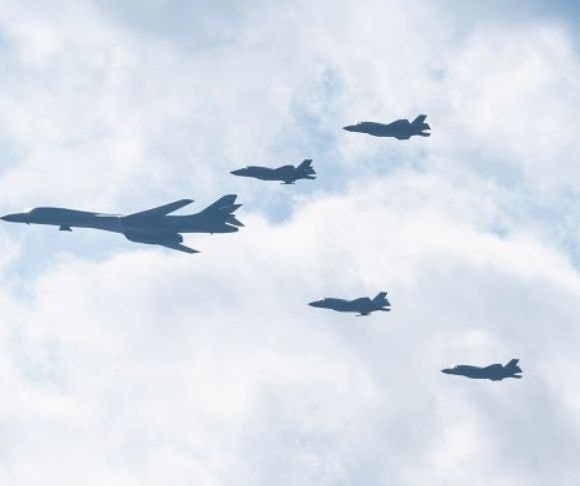The US Air Force has a limited number of fifth-generation, stealth F-22 interceptor fighters with a smaller percentage being combat-ready. Despite being developed in the early 1990s, the F-22 Raptor air superiority fighter is the most advanced aerial combat aircraft in the world. So, why would the Air Force include in the FY2023 President’s Budget a request to retire F-22s, the US’s most capable fighter? It’s a good question. Congress is wondering the same thing. Nonetheless, 33 Raptors are on the retirement chopping block, and Congress is pushing back on the idea in the FY2023 National Defense Authorization Bill (NDAA).
When reading about combat aircraft retirements, the impression is the weapon systems have been around for decades and are ready for the boneyard. However, the F-22 has been operationally capable for about 15 years. The first Raptor fighter wing to be declared “Full Operational Capability” (FOC) was the 1st Fighter Wing at Langley Air Force Base, VA. “FOC signifies the Raptor has fulfilled all performance and operational requirements for the weapon system,” the Air Combat Command Commander at the time, General John Corley, announced in 2007. Manufacturer Lockheed Martin delivered the last production F-22 to the Air Force in 2012. Consequently, as far as weapon systems go, the F-22 is one of the youngest in the US Armed Forces.
Retire F-22s: A Precious Capability
Furthermore, the fifth-generation stealth fighter is precious in its limited quantity. Of the 195 jets delivered, 187 were designated as operational. Because of accident losses in 2004, 2009, 2010, and 2020 and aircraft used in further testing and training, there are less than 170 F-22s capable of being ready for operational missions. Older F-22s were taken out of service and placed in storage after running out of airframe life. Using up the operating life of aircraft rapidly happens in military aircraft manufacturing when the production rate is low and the build-out is stretched over years, if not decades.
The early deliveries age quickly and run out of useful operational life. For example, the average annual production rate for the F-22 was approximately 13. Compare that number with the rate for F-35, Defense Department’s newest stealth fighter, which is over 125 annually. Until recently, the US Air Force “at present plans to operate the Raptor through the 2050s,” David Axe reported in Forbes.
Some of the capabilities of the F-22 putting in an air combat league of its own are its ability to go supersonic, Mach 1.5 plus, while in military power without the aid of afterburners. Conventional supersonic aircraft use afterburners to achieve speeds faster than sound. Additionally, though the Raptor is in its element as an air-to-air superstar carrying a variety of short and long-range anti-aircraft missiles, the fighter can carry air-to-ground bombs and missiles, expanding its aerial lethality.
Air Force Thinks It Has a Better Idea
 Despite the remarkable capability of the F-22, the Air Force is convinced it has a better idea for air superiority: “to cut the F-22s is part of a broader plan to divest 150 aircraft in fiscal 2023 to free funds for higher priorities such as the B-21 bomber, hypersonic weapons programs and Next-Generation Air Dominance (NGAD) systems,” according to Courtney Albon in Defense News. The Air Force also plans to move forward with what it calls the Collaborative Combat Aircraft (CCA), unmanned fighters complementing the NGAD and other fighters. The problem is, if the Air Force is allowed to retire 33 F-22s, there is nothing to replace their highly advanced capability. NGAD and CCA are future programs. The multi-service F-35s are primarily designed for air-to-ground, close air support and were part of force planning that assumed the current number of F-22s were part of the mix.
Despite the remarkable capability of the F-22, the Air Force is convinced it has a better idea for air superiority: “to cut the F-22s is part of a broader plan to divest 150 aircraft in fiscal 2023 to free funds for higher priorities such as the B-21 bomber, hypersonic weapons programs and Next-Generation Air Dominance (NGAD) systems,” according to Courtney Albon in Defense News. The Air Force also plans to move forward with what it calls the Collaborative Combat Aircraft (CCA), unmanned fighters complementing the NGAD and other fighters. The problem is, if the Air Force is allowed to retire 33 F-22s, there is nothing to replace their highly advanced capability. NGAD and CCA are future programs. The multi-service F-35s are primarily designed for air-to-ground, close air support and were part of force planning that assumed the current number of F-22s were part of the mix.
Cooler heads on the House Armed Services Committee are having none of taking F-22s out of the inventory. “Not only did lawmakers reject the plan to cut the aircraft, they called for the older-model jets, which are used primarily for training missions, to be upgraded to the newest F-22 configuration,” Albon reported. The Senate Armed Services Committee in its version of the FY2023 NDAA mandated the Air Force cannot retire F-22s. Congress sees the problem clearly. The Air Force is on a path to sacrifice existing air superiority capability in hopes of achieving a capability in the future, mainly existing in PowerPoint charts. Fleets of remotely piloted vehicles have not been proven in a peer-on-peer aerial combat environment. It seems foolhardy to give up proven, highly advanced fighter capability when China and Russia represent a threat now.
The views expressed are those of the author and not of any other affiliation.




